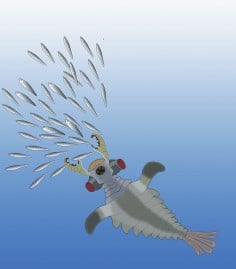Rare fossils in China show brain structures of prehistoric predators
Strange creatures' nerve structures captured for first time in fossils in China

The fossils show an animal called Lyrarapax unguispinus that lived during the Cambrian Period, a pivotal juncture in the history of life on Earth when many major animal groups first appeared. It was a member of a group known as anomalocaridids - primitive relatives of arthropods, which include crustaceans, insects and spiders - that hunted prey with a pair of claw-like, grasping appendages in front of the eyes.
Even though anomalocaridids do not have any direct descendants alive today, the brain structures of Lyrarapax closely resemble those of worm-like animals called velvet worms that crawl along the ground in tropical and semitropical forests in the southern hemisphere.
The researchers said the similarities suggest that velvet worms may be very distant cousins of the anomalocaridids, whose best-known example is Anomalocaris, known from a Canadian fossil site called the Burgess Shale.
Velvet worms, land animals also known as onychophorans, grow to a few centimetres in length, have two long feelers extending from the head and have numerous pairs of stubby, unjointed tubular legs that each end in a pair of small claws.
Lyrarapax, whose scientific name means spiny-clawed, lyre-shaped predator, lived 520 million years ago.